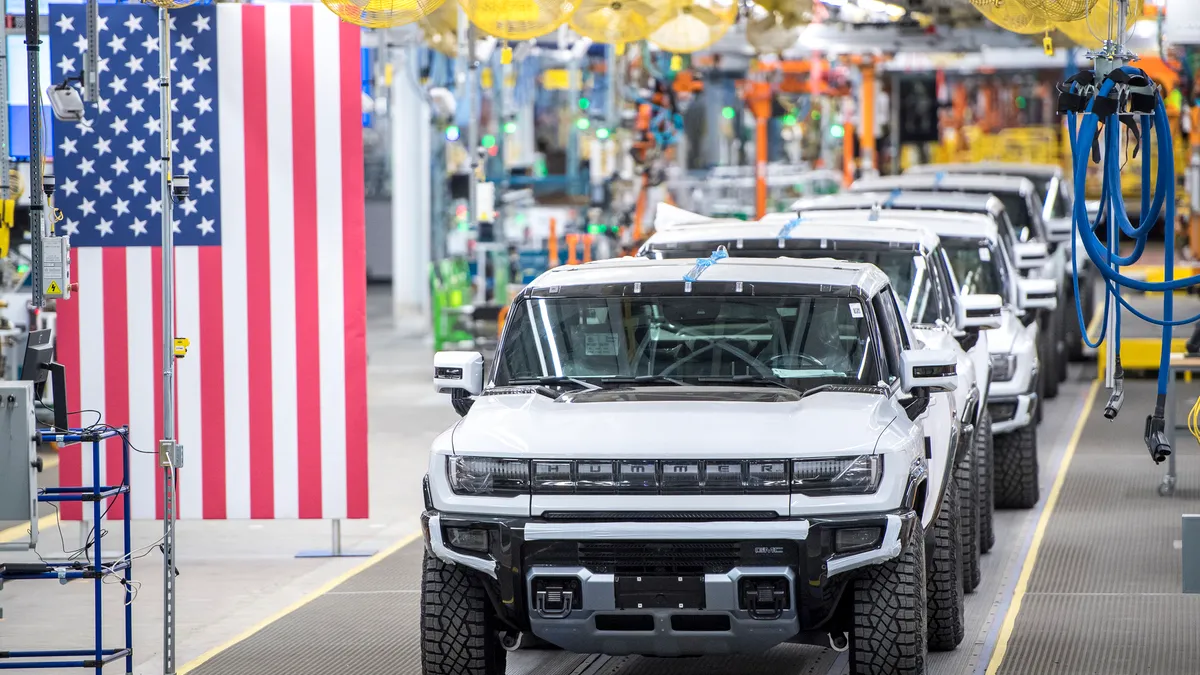Dive Brief:
- The Biden administration on Wednesday announced it has approved the electric vehicle charging network plans submitted by 35 states, representing $900 million in investment for Fiscal Years 2022 and 2023.
- The National Electric Vehicle Infrastructure program, or NEVI, will be rolling out $5 billion in funding over a five-year period to install chargers across 53,000 miles of U.S. highways. Officials say remaining state plans will continue to be reviewed on a rolling basis.
- The federal government’s EV and battery investments fit alongside larger commitments from major automakers to revamp supply chains and develop their own charging networks. GM is planning $35 billion in EV-related spending from 2020 to 2025, while Ford is planning $11.4 billion across a similar time frame.
Dive Insight:
President Joe Biden was at the Detroit Auto Show on Wednesday to announce the NEVI funding approvals and test drive new vehicles. He vowed "the great American road trip is going to be fully electrified.”
The president has set a goal for half of new U.S. car sales to be electric by 2030. Experts say achieving that level of EV adoption will require expanding domestic battery production capacity, in part due to purchasing requirements tied to federal incentives.
The Federal Highway Administration has said it is working to develop rules for how formula NEVI funds can be spent, and indicated it will finalize that rulemaking “expeditiously.” The rules would set standards for the national charging network, and the agency said it is considering a waiver from domestic purchase requirements “that will allow a short ramp up period for the domestic manufacturing of EV charging.”
Global battery production is now dominated by China, but U.S. automakers are working quickly to onshore that industry. EV purchase incentives also hinge on components manufactured in the U.S.
Ford is building three new battery plants in the U.S. with a total capacity of 129 GWh, and production is expected to start by 2025.
“Our next generation of EVs are coming, leveraging advances in cell chemistry, battery pack design and battery management software,” Charles Poon, Ford’s global director of electrified systems engineering, said Wednesday at the Novi Battery Show, outside of Detroit.
The conference is hosted by Informa, which recently purchased Industry Dive.
Poon said Ford plans to deliver 2 million EVs by 2026, but added that its strategy depends the development of sustainable supply chains, including recycling battery materials.
Nickel and lithium costs “may increase by another eight- and 11-fold by the end of the decade,” he said. “We estimate by 2035, as much as 30% of battery materials can be met by recycling, and we're working hard to make sure the ecosystem will be ready.”
Ford on Wednesday also instituted new requirements for dealerships to sell its electric vehicles, including making investments in EV charging.
GM is targeting annual global EV sales of more than 1 million by 2025 and is developing four of its own battery plants.
The company is overhauling its manufacturing process to embrace an electric future, and in tandem is focused on developing new battery chemistries. Through a joint venture with LG Chem, the auto manufacturer says it will reduce battery cell costs below $100/kWh.
“With the new technology that we have, we honestly don't know the bottom there,” said Tim Grewe, GM’s general director of electrification strategy and cell engineering.
Toyota is also building battery plants, Volkswagen is eyeing U.S. production and Tesla has Gigafactories in Nevada and New York.
The partnerships are about more than just securing battery cells, however, said Robert Galyen, formerly the chief technology officer at CATL, the world’s largest battery manufacturer.
“Joint ventures are a big deal right now. It's another way of shielding the car manufacturers and the [original equipment manufacturers] from the legal system,” Galyen said during his Tuesday keynote address at the Novi battery conference.
“We see lots of battery companies and a lot of car companies partnering with each other. ... Because if a joint venture makes the battery, it's their sole responsibility to make sure that battery system is safe,” Galyen said. “And then the court system will not go after the OEM. So it's a great way of protecting the OEMs.”
The same approach “cascades not only from the OEMs and the car battery manufacturers, but it goes right down to the supply chain,” Galyen said. “Many of the supply chain guys are getting partnerships established with the battery manufacturers in a way that they can do more cost-effective business.”















